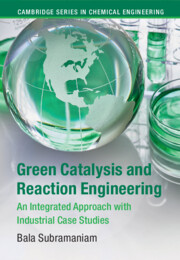Book contents
- Green Catalysis and Reaction Engineering
- Cambridge Series in Chemical Engineering
- Green Catalysis and Reaction Engineering
- Copyright page
- Dedication
- Contents
- Preface
- Acknowledgments
- 1 Sustainability Challenges of the Chemical Industry
- 2 Multiphase Catalytic Processes and Sustainability Challenges
- 3 Ethylene Production from Diverse Feedstocks and Energy Sources
- 4 Ethylene Epoxidation in Gas-Expanded Liquids with Negligible CO2 Formation as a Byproduct
- 5 Spray Reactor-Based Terephthalic Acid Production as a Greener Alternative to the Mid-Century Process
- 6 Sustainability Assessments of Hydrogen Peroxide-Based and Tertiary Butyl Hydroperoxide-Based Propylene Oxide Technologies
- 7 Separation of Propane/Propylene Mixture by Selective Propylene Hydroformylation in Gas-Expanded Liquids
- 8 A Greener Higher Olefin Hydroformylation Process
- 9 Solid Acid-Catalyzed Olefin/Isoparaffin Alkylation in Supercritical Carbon Dioxide
- 10 Epilogue
- Index
- References
4 - Ethylene Epoxidation in Gas-Expanded Liquids with Negligible CO2 Formation as a Byproduct
Comparative Sustainability Analysis with Conventional Process
Published online by Cambridge University Press: 15 September 2022
- Green Catalysis and Reaction Engineering
- Cambridge Series in Chemical Engineering
- Green Catalysis and Reaction Engineering
- Copyright page
- Dedication
- Contents
- Preface
- Acknowledgments
- 1 Sustainability Challenges of the Chemical Industry
- 2 Multiphase Catalytic Processes and Sustainability Challenges
- 3 Ethylene Production from Diverse Feedstocks and Energy Sources
- 4 Ethylene Epoxidation in Gas-Expanded Liquids with Negligible CO2 Formation as a Byproduct
- 5 Spray Reactor-Based Terephthalic Acid Production as a Greener Alternative to the Mid-Century Process
- 6 Sustainability Assessments of Hydrogen Peroxide-Based and Tertiary Butyl Hydroperoxide-Based Propylene Oxide Technologies
- 7 Separation of Propane/Propylene Mixture by Selective Propylene Hydroformylation in Gas-Expanded Liquids
- 8 A Greener Higher Olefin Hydroformylation Process
- 9 Solid Acid-Catalyzed Olefin/Isoparaffin Alkylation in Supercritical Carbon Dioxide
- 10 Epilogue
- Index
- References
Summary
Ethylene oxide (EO) is a commodity chemical made by treating ethylene with oxygen over a silver-based catalyst. One of its major applications is for making polyethylene terephthalate (PET) plastics used in water bottles. In the conventional process, up to 15% of the ethylene is simply burned as CO2. This chapter discusses an alternative process that employs methyltrioxorhenium (MTO) as a catalyst and hydrogen peroxide (H2O2) as an oxidant to produce EO with no CO2 as a byproduct. While the capital costs for both processes are similar, the EO production cost for the alternative process is competitive only if the MTO catalyst remains stable for at least one year and the Re leaching is <0.7 ppm. Unexpectedly, cradle-to-gate life cycle assessments (LCA) reveal that the overall environmental impacts on greenhouse gas emissions, air quality and water quality are similar for both processes. In the alternate technology, the carbon footprint associated with H2O2 production reduces the gains made in converting ethylene to EO avoiding CO2 as a byproduct. Direct H2O2 synthesis technology and effective H2O2 utilization are essential to reduce the environmental footprint of the alternate technology.
- Type
- Chapter
- Information
- Green Catalysis and Reaction EngineeringAn Integrated Approach with Industrial Case Studies, pp. 67 - 88Publisher: Cambridge University PressPrint publication year: 2022

